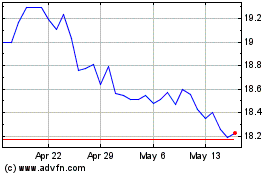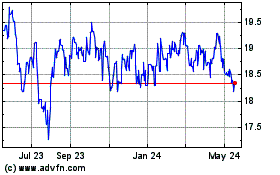Dollar Extends Decline After Weak U.S. Retail Sales Data
15 January 2016 - 8:34PM
RTTF2
The U.S. dollar extended its early decline against most major
currencies in European deals on Friday, as retail sales fell
modestly in December, while lingering worries about Chinese economy
and falling oil prices revived worries about global growth
outlook.
Data from the Commerce Department showed that retail sales edged
down by 0.1 percent in December following an upwardly revised 0.4
percent increase in November.
Economists had expected sales to come in unchanged compared to
the 0.2 percent uptick originally reported for the previous
month.
Excluding auto sales, retail sales still dipped by 0.1 percent
in December after climbing by 0.3 percent in November. Ex-auto
sales had been expected to rise by 0.2 percent.
Another report from the Labor Department showed that the U.S.
producer prices fell slightly more-than-expected in December,
reflected by steep drops in prices for food and energy.
The producer price index for final demand dipped by 0.2 in
December after rising 0.3 percent in November. Economists had
expected prices to edge down by 0.1 percent.
Excluding food and energy prices, core producer prices inched up
by 0.1 in December after climbing 0.3 percent in the previous
month. The modest uptick matched economist estimates.
The greenback showed mixed performance in Asian trading. While
the currency declined against the euro and the yen, it was steady
against the franc. Against the pound, it climbed.
Extending early decline, the greenback fell to near a 5-month
low of 116.60 against the Japanese yen, coming off from its prior
high of 118.27. The next downside target for the greenback-yen pair
is seen around the 115.00 mark.
The Japanese central bank is not planning to ease policy further
now, but policymakers stand ready to adjust stance if needed, Bank
of Japan Governor Haruhiko Kuroda said.
The central bank chief said the bank does not have plans for
further monetary easing "at the moment".
The greenback slid to 1.0984 against the European currency, its
lowest since December 29, 2015. On the downside, 1.11 is likely
seen as the next support level for the greenback.
Data from Eurostat showed that the euro area trade surplus hit a
nine-month high in November as exports increased amid fall in
imports.
The trade surplus rose to a seasonally adjusted EUR 22.7 billion
from EUR 19.8 billion in October. This was the highest since
February, when it totaled EUR 23.1 billion. Also, it stayed above
the expected level of EUR 21 billion.
Reversing from an early high of 1.0060 against the Swiss franc,
the greenback dropped to a 4-day low of 0.9958. Continuation of the
greenback's downtrend may take it to a support surrounding the 0.98
level.
The greenback eased back to 1.4457 against the loonie, from near
a 13-year low of 1.4547 hit at 4:20 am ET. The greenback is seen
finding support around the 1.43 area.
The greenback held firm around an early 5-1/2-year high of
1.4325 against the pound, compared to Thursday's closing value of
1.4410. If the greenback extends rise, 1.42 is possibly seen as its
next resistance level.
Figures from the Office for National Statistics showed that U.K.
construction output dropped unexpectedly in November.
Construction output fell 0.5 percent month-on-month in November,
reversing a 0.2 percent rise in October. Economists had forecast a
0.5 percent rise for November.
U.S. business inventories data for November, U.S. Baker Hughes
rig count data and the University of Michigan's preliminary U.S.
consumer sentiment index for January are slated for release
shortly.
At 1:00 pm ET, Federal Reserve Bank of Dallas President Robert
Kaplan is scheduled to participate in a moderated Q&A session
before the Dallas Assembly Luncheon hosted by the Federal Reserve
Bank of Dallas.
US Dollar vs ZAR (FX:USDZAR)
Forex Chart
From Jun 2024 to Jul 2024

US Dollar vs ZAR (FX:USDZAR)
Forex Chart
From Jul 2023 to Jul 2024
